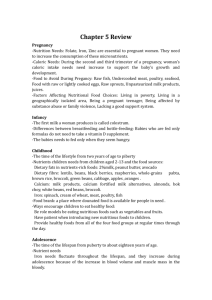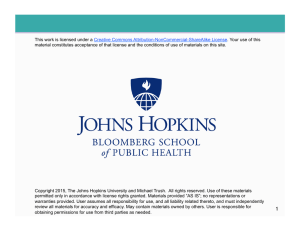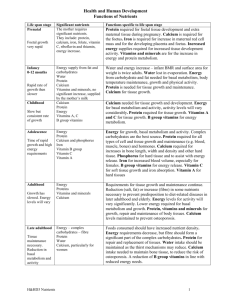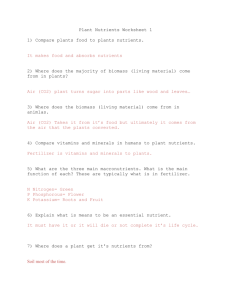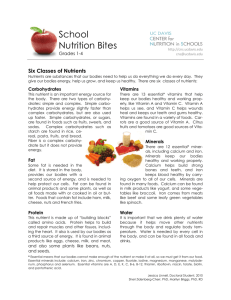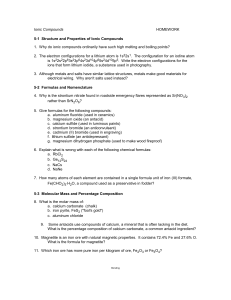Nutrition across the life span
advertisement
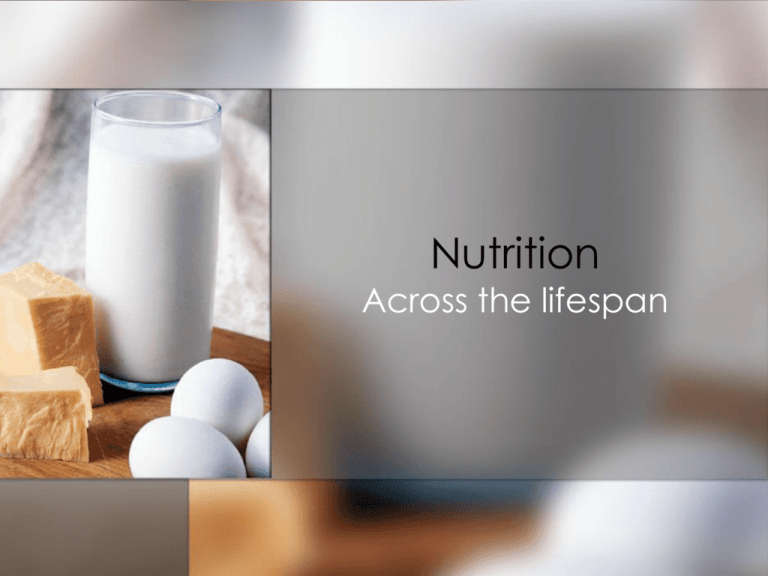
Nutrition Across the lifespan Nutrition Across the Lifespan All nutrients are required across the lifespan. The needs change across the different stages of the lifespan To acquire the required daily nutrients it is important to consume a wide variety of nutritious food across the lifespan. Pregnancy and Lactating Women An increase in energy especially during breastfeeding approximately 20% No need to eat for “two”, its more eating a balanced diet. During pregnancy the woman’s appetite may change What the woman chooses to eat will affect her health and the health of her emryo/fetus Pregnancy and Lactating Women The main nutrients required during pregnancy and lactating women. (hand out table from Journey through HHD) Protein Folate Iron Vitamin C B group vitamins Minerals Infancy Need smaller quantities Infants can increase in length by 50% and weight by 300% between birth and 1 year Breast milk is preferred to formula due to the large number of protective and immunological factors Infancy Water: Very susceptible to dehydration during early infancy. Breast milk or correctly prepared infant formula usually provides enough water Fats: Provide a source of energy for growth and acts as a carrier for fat soluble vitamins. Gets fat from breast milk. Protein: Required for rapid cell duplication and release of growth hormone. Carbohydrates: Needed for energy for BMR. Infants BMR is twice the rate of adults due to the rapid growth and need for energy. Folate: Helps the body form red blood cells, helps with the formation of DNA and helps cells grow and divide. Calcium: Required for growth of teeth, lengthening and ossification of bones. Childhood Children's appetites tend to vary as their growth patterns and physical activity needs change. A child’s nutrient needs change as they get older and their body size increases. Childhood Carbohydrates: Most important energy source for children. Should eat it in its complex form such as fruit, vegetables and wholegrain cereals. Energy needs increase throughout childhood as they grow and their activity levels increase and their muscle. Protein: Need for protein increase steadily throughout as both hard and soft tissue continues to form. Protein forms the matrix of all tissue in the body. B group vitamins: Allows energy to be released and are water soluble. Calcium: Needed for the ossification process of bone and teeth. Its required in large amounts during childhood. Iron: Required for the increase in blood volume as the body grows larger. Adolescence A time for rapid growth An adolescent’s nutritional needs are greater than any other time of the life except during pregnancy and lactation. Meeting nutritional needs during adolescence maybe hindered by behaviours such as skipping meals, dieting, take away foods etc… Adolescence Calcium: is needed for the lengthening and ossification of bones. They need to reach their peak bone mass. Calcium in the bloodstream is important for muscle contraction and conduction of nerve impulses. Iron: Needed for the increase in blood volume, energy and for females to replace the blood lost during menstruation. Protein: Needed for rapid growth of soft tissue as well as bone lengthening during adolescence. Needed for the formation of hormones. Vitamin C: Function to release energy. Works together with protein to form connective tissue, also needed for the absorption of iron. Carbohydrates: During the growth spurt energy needs are high but after the main years of growth, energy needs are related more to physical activity levels. B group vitamins: Required for energy levels. Quantities increase according to energy levels. Adulthood Growth has ceased Nutrients still needed for maintenance and repair of body tissues Nutrients maybe needed for protective factors such as fibre to help reduce blood cholesterol, antioxidants to help protect against disease. Adulthood Protein: Needed for the replacement of cells Calcium: Maintain bone density Iron: The intake of iron needs to be maintained to ensure adequate blood formation in order to prevent anaemia. Older Adults Food and energy intake decline as appetite and hunger change. Physical activity and level of health change Hard to reach a nutritionally adequate diet Need to reach at least the same if not more levels of intake of most vitamins, minerals and protein Older Adults Fibre: For the digestive system, to aid in the passage of food. Helps prevent illness such as colon cancer. Calcium: Will help protect the body against developing osteoporosis. Calcium is lost through urine and needs to be replaced. When oestrogen levels in menopausal women drop. Protein: Needs to stay the same as adulthood. Need it for the maintenance of body tissue and replacement of dead cells.
